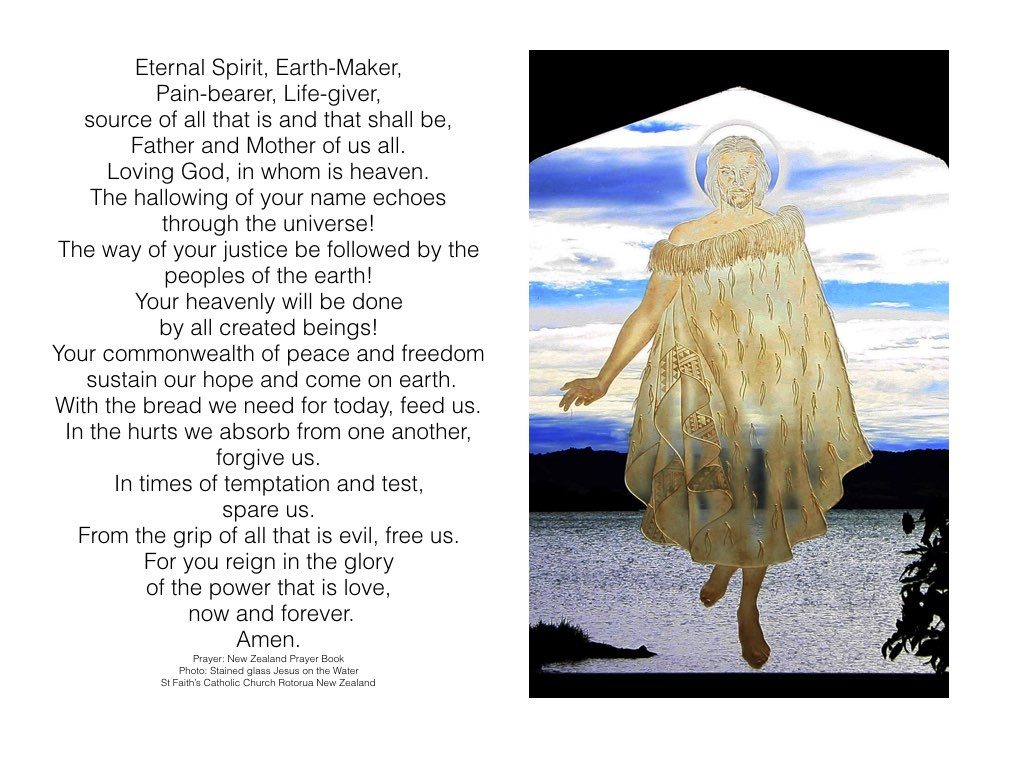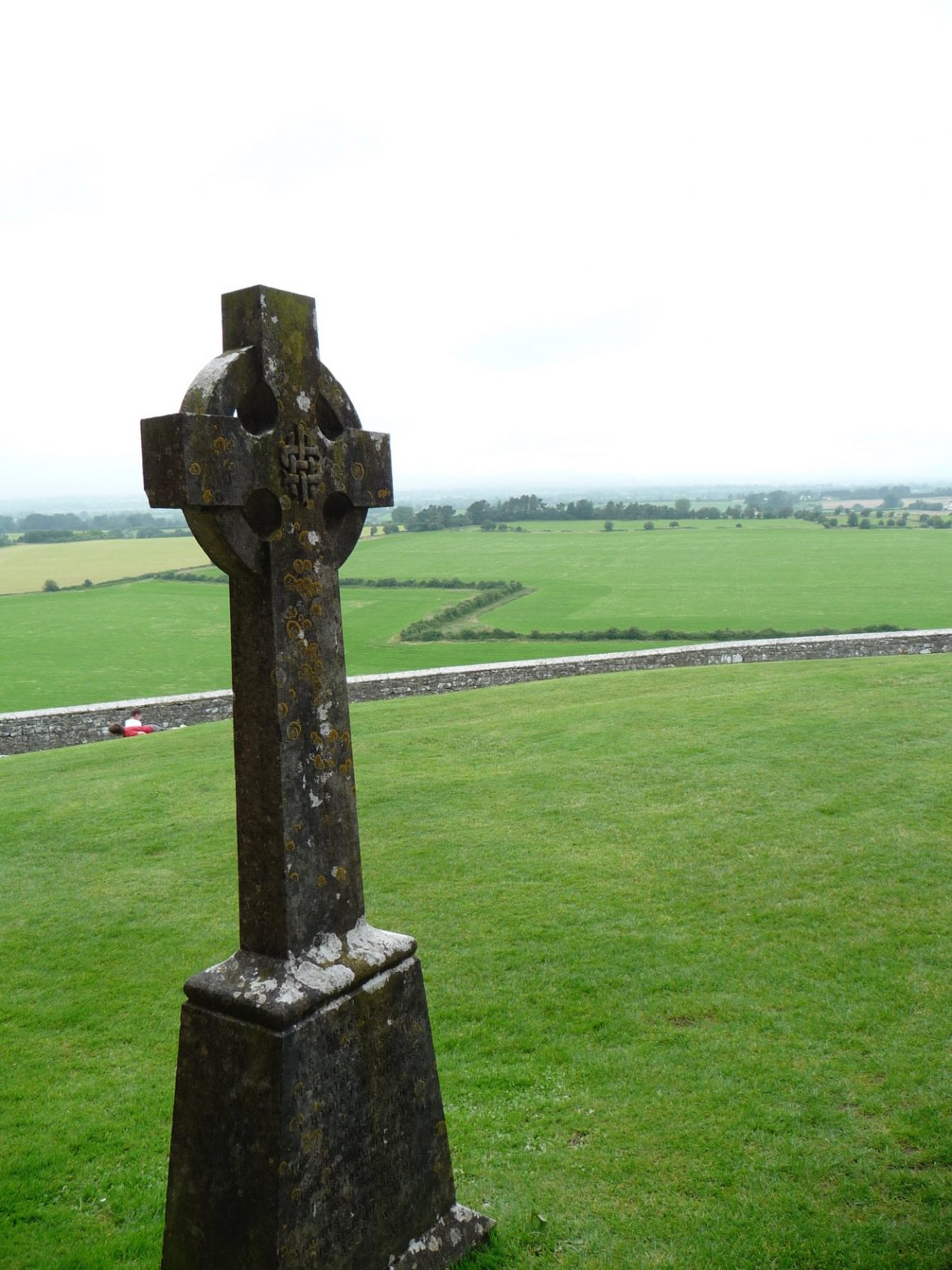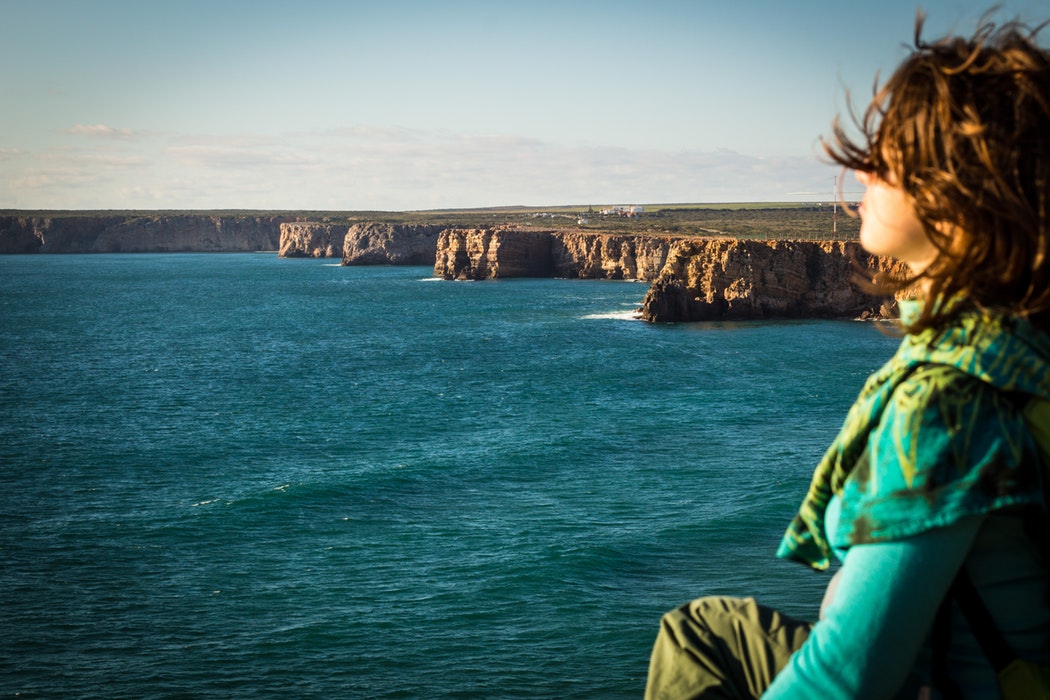GERTRUDE OF NIVELLES
Patron Saint of Cats
626 AD-March 17, 659AD
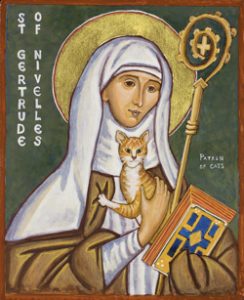
St. Gertrude of Nivelles is best known as the Patron saint of cats. Now, that intrigues me as I love animals of all kinds, yet I have two cats who share their life with me or should I say they let me serve them. Yet, interestingly, no one knows why Gertrude is the Patron Saint of Cats, as there is nothing written about her with felines. The only guess for this designation is that there are some medieval depictions of her surrounded by mice. It was not even until the 1980’s that St. Gertrude became the Patron saint of cats.
So, let’s take a look at what we know about this saint who is not as well-known as some other female saints. St. Gertrude of Nivelles was born into aristocracy in Belgium in about 626AD. She was the daughter of Pepin of Landen, the mayor of the Austrasia palace (whose descendants through his daughter Begga’s marriage to Ansegisel later became the founders of the Carolingian Empire) and his wife Itta of Metz. There must have been strong-willed genes in that family as Gertrude herself was strong-minded from childhood.
One day when Gertrude was ten years old, King Dagobert I, King of Austrasia, king of all the Franks, and king of Neustria and Burgundy came to have dinner with her family. A young man who was the son of the Duke of Austrasia was at a dinner party with the family. He asked the King to grant him Gertrude’s hand in marriage. When Pepin asked his daughter if she agreed to this engagement, she angrily rejected the proposal and with an oath said that she would neither have him nor any other earthly spouse, only Christ. Yes, she was only ten!
As Gertrude grew older, she and her Mother Itta set up an Irish- inspired monastery in the ancient Sonian Forest at Nivelles. It is said that it was filled with treasured handwritten books. Itta was the first Abbess and then Gertrude followed in her footsteps. This Mother and daughter became good friends with the famous Irish missionary St. Fursey and his brothers Foillan and Ultan who first served in East Anglia in southeastern England and then in France.
Gertrude soon began to assign her abbess tasks to others so that she could spend more time in spiritual tasks such as in prayer, in reading, and in scholarly study. She began to build and to support numerous churches that she dedicated to the saints and she ministered to orphans, widows, captives, and pilgrims.
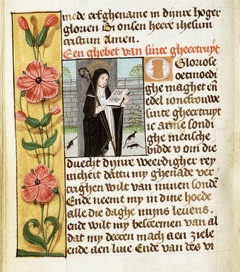
Page from Manuscript with St. Gertrude and mice. National Museum of the Netherlands
When Gertrude became fatigued and ill at age 33 in 659 AD from extensive caring for others, she appointed her niece Wulftrude (the daughter of her brother Grimoald I) as Abbess. That same year, Gertrude asked a pilgrim (likely Ultan) from Fosses Monastery when she would die and he prophesied that she would die the very next day on March 17, 659 on Irish St. Patrick’s feast day. He also said that Patrick along with the angels would greet her and just as he prophesied she did die on St. Patrick’s feast day.
Gertrude left instructions on how she wanted her nuns to bury her in an old veil that a pilgrim nun had left at Nivelles along with a scratchy hair shirt. Her vita says that at her death there was a most pleasant odor,” a s if a burning mixture of scents, and it perfumed that little cell where the holy body lay. And we, having gone out from there, still sensed the sweetness of that wonderful scent in our nostrils.”
Her *vita beautifully describes this good Abbess:
“Gertrude did not cease to speak in constant praying and in preaching the word of God to her people. Rejoicing in hope, bearing up in tribulation, devoted in her heart, and calm in her appearance, she longed for her last day to be present, the day of her heavenly journey.”
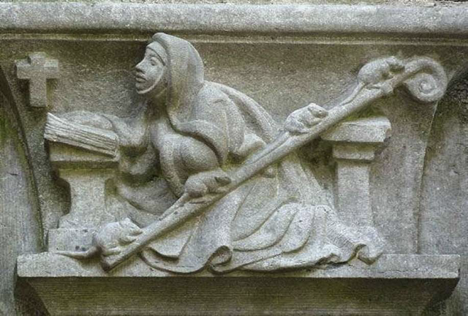
Notice the mice on St. Gertrude of Nivelles’ staff. console oudegracht_321. photo from KATTENKRUID VIA WIKIMEDIA // CC BY 3.0
It was recorded that even after Gertrude’s short life of 33 years on earth, that she continued her charisma of caring for the suffering of others from the other side of the thin veil. Gertrude’s compassionate care from the heavenlies included saving lives at sea; stopping a fire in a monastery; curing a girl of her blindness; helping a young boy escape kidnappers; rescuing a man in chains; and resuscitating a servant boy along with many other good works.
And Jesus said, “when you have done it to the least of these, you have done it to Me.” Well done, good and faithful servant St. Gertrude of Nivelles.
*Vita Sanctae Geretrudis (The Life of St. Gertrud) and the Additamentum Nivialense de Fuilano (the Nivelles Supplement to the Vita Fursei concerning Foillan) in Fouracre, Paul and Richard A. Gerberding. Late Merovingian France: History and Hagiography 640-720.Manchester, UK: Manchester University Press, 1996.
Rev. Brenda Griffin Warren is an ordained Christian Church (Disciples of Christ) Pastor who now serves in Interim Ministry. She is married with two grown sons, a daughter-in-love, and two Maine Coon cats who bear Celtic names. She writes on the Celtic and Anglo-Saxon saints at www.saintsbridge.org.
Icon by Jennifer Richard-Morrow
ST. GERTRUDE OF NIVELLES
Patron Saint of Cats
626 AD-March 17, 659AD
By Rev. Brenda Griffin Warren
March 17th is not just St Patrick’s Day it is also the feast day for another Celtic saint, Gertrude of Nivelles. Interestingly, Gertrude asked an Irish monk on March 16 when she would die and he said tomorrow. She knew that was St. Patrick’s feast day and she was elated. The monk told her that St. Patrick and the angels would be greeting her.
St. Gertrude of Nivelles is best known as the Patron saint of cats. Now, that intrigues me as I love animals of all kinds, yet I have two cats who share their life with me or should I say they let me serve them. Yet, interestingly, no one knows why Gertrude is the Patron Saint of Cats, as there is nothing written about her with felines. The only guess for this designation is that there are some medieval depictions of her surrounded by mice. It was not even until the 1980’s that St. Gertrude became the Patron saint of cats.
So, let’s take a look at what we know about this saint who is not as well-known as some other female saints. St. Gertrude of Nivelles was born into aristocracy in Belgium in about 626AD. She was the daughter of Pepin of Landen, the mayor of the Austrasia palace (whose descendants through his daughter Begga’s marriage to Ansegisel later became the founders of the Carolingian Empire) and his wife Itta of Metz. There must have been strong-willed genes in that family as Gertrude herself was strong-minded from childhood.
One day when Gertrude was ten years old, King Dagobert I, King of Austrasia, king of all the Franks, and king of Neustria and Burgundy came to have dinner with her family. A young man who was the son of the Duke of Austrasia was at a dinner party with the family. He asked the King to grant him Gertrude’s hand in marriage. When Pepin asked his daughter if she agreed to this engagement, she angrily rejected the proposal and with an oath said that she would neither have him nor any other earthly spouse, only Christ. Yes, she was only ten!
As Gertrude grew older, she and her Mother Itta set up an Irish- inspired monastery in the ancient Sonian Forest at Nivelles. It is said that it was filled with treasured handwritten books. Itta was the first Abbess and then Gertrude followed in her footsteps. This Mother and daughter became good friends with the famous Irish missionary St. Fursey and his brothers Foillan and Ultan who first served in East Anglia in southeastern England and then in France.
Gertrude soon began to assign her abbess tasks to others so that she could spend more time in spiritual tasks such as in prayer, in reading, and in scholarly study. She began to build and to support numerous churches that she dedicated to the saints and she ministered to orphans, widows, captives, and pilgrims..

Page from Manuscript with St. Gertrude and mice. National Museum of the Netherlands
When Gertrude became fatigued and ill at age 33 in 659 AD from extensive caring for others, she appointed her niece Wulftrude (the daughter of her brother Grimoald I) as Abbess. That same year, Gertrude asked a pilgrim (likely Ultan) from Fosses Monastery when she would die and he prophesied that she would die the very next day on March 17, 659 on Irish St. Patrick’s feast day. He also said that Patrick along with the angels would greet her and just as he prophesied she did die on St. Patrick’s feast day.
Gertrude left instructions on how she wanted her nuns to bury her in an old veil that a pilgrim nun had left at Nivelles along with a scratchy hair shirt. Her vita says that at her death there was a most pleasant odor,” a s if a burning mixture of scents, and it perfumed that little cell where the holy body lay. And we, having gone out from there, still sensed the sweetness of that wonderful scent in our nostrils.”
Her *vita beautifully describes this good Abbess:
“Gertrude did not cease to speak in constant praying and in preaching the word of God to her people. Rejoicing in hope, bearing up in tribulation, devoted in her heart, and calm in her appearance, she longed for her last day to be present, the day of her heavenly journey.”

Notice the mice on St. Gertrude of Nivelles’ staff. console oudegracht_321. photo from KATTENKRUID VIA WIKIMEDIA // CC BY 3.0
It was recorded that even after Gertrude’s short life of 33 years on earth, that she continued her charisma of caring for the suffering of others from the other side of the thin veil. Gertrude’s compassionate care from the heavenlies included saving lives at sea; stopping a fire in a monastery; curing a girl of her blindness; helping a young boy escape kidnappers; rescuing a man in chains; and resuscitating a servant boy along with many other good works.
And Jesus said, “when you have done it to the least of these, you have done it to Me.” Well done, good and faithful servant St. Gertrude of Nivelles.
*Vita Sanctae Geretrudis (The Life of St. Gertrud) and the Additamentum Nivialense de Fuilano (the Nivelles Supplement to the Vita Fursei concerning Foillan) in Fouracre, Paul and Richard A. Gerberding. Late Merovingian France: History and Hagiography 640-720.Manchester, UK: Manchester University Press, 1996.
Rev. Brenda Griffin Warren is an ordained Christian Church (Disciples of Christ) Pastor who now serves in Interim Ministry. She is married with two grown sons, a daughter-in-love, and two Maine Coon cats who bear Celtic names. She writes on the Celtic and Anglo-Saxon saints at www.saintsbridge.org.
March 17th is St Patrick’s Day and while many here in the US think only of green beer with corned beef and cabbage some are aware that this is a day to remember one who helped to spread the gospel in a time of darkness and oppression. It seems a very pertinent celebration for the season of Lent and as we grapple with our responses to those who are enslaved and abused in our society.
Brad Culver tells us:
In Patrick’s Letter to Coroticus he speaks out against Croticus a British slave trader whose soldiers were raiding along the Irish coast slaughtering men and taking women and children back to England to be sold as slaves. The Letter is an especially important document because it shows St. Patrick as the first to speak out against slavery and in defense of women. As one who had been enslaved himself, Patrick proclaims his authority as a Bishop and speaks out against the kidnapping and murder perpetrated by his Roman countrymen. Read the article here
St Patrick prayers are particularly powerful tools to help us focus our faith and draw closer to God. Though St Patrick’s breastplate is the best know of these, there are others like the one above that are equally as powerful.
Going Green For St Patrick’s Day
If you really want to go green for St Patrick’s Day in honour of St Patrick who often used examples from creation to illustrate his points, consider these ideas:
- Eat locally grown corned beef and cabbage or better yet consider a vegetarian option like potato leek soup and soda bread made from local grains. Scientific American reported in 2009 that producing half a pound of corn-fed hamburger releases as much greenhouse gas into the atmosphere as driving a 3,000 pound car nearly 10 miles.
- Drink only local brews
- Toss green bird seed instead of confetti at your St Patrick’s Day parade.
- Plant something green in the garden or buy a green plant for the house.
Read Through Patrick’s Breastplate
Or you may like to read through Patrick’s Breastplate listen to this beautiful rendition of Patrick’s breastplate
Or listen to this wonderful retelling of the story of Patrick and the beautiful harp guitar music that goes with it.
And if you want to hear about St Patrick from a kid’s perspective watch this. It is delightful
And just because I could not resist adding my own stamp to St Patrick’s Day here is my rendition of the prayer in a responsive litany:
We bind unto ourselves today
the strong name of the trinity,
By invocation of the same,
the Three in One and One in three.
We bind this day to us forever, by power of faith, Christ’s Incarnation;
His baptism in the Jordan River; his death on cross for my salvation;
His bursting from the spiced tomb; His riding up the heavenly way;
his coming at the day of doom; We bind unto ourselves today.
We cast off the works of darkness today,
And put on the armour of light,
Light before us and behind,
Light within and light without,
Light to guide and to lead us,
Let us clothe ourselves with Christ.
Christ behind us, Christ before us,
Christ beside us, Christ to win us,
Christ to comfort and restore me,
Christ beneath us, Christ above us,
Christ in quiet, Christ in danger,
Christ in hearts of all that love us,
Christ in mouth of friend & stranger
Let us wrap ourselves around with the belt of truth,
And strap on the breastplate of righteousness,
Let us clad our feet with the gospel of peace,
place the helmet of salvation on our heads.
And take up the shield of faith.
Let us clothe ourselves with Christ.
We bind unto ourselves today, the power of God to hold and lead,
God’s eye to watch, God’s might to stay, God’s ear to harken to our need,
The wisdom of our God to teach, God’s hand to guide, and shield to ward,
The Word of God to give us speech, God’s heavenly host to be our guard.
In the love of God who shelters us,
In the light of Christ who walks beside us,
In the power of the Spirit who dwells within us,
We place ourselves today.
Let us clothe ourselves with Christ.
We bind unto ourselves today the strong name of the Trinity,
By invocation of the same, the Three in One, the One in Three.
Of whom all nature hath creation, Eternal God, Spirit, Word;
Praise to the God of our salvation, Salvation is of Christ the Lord.
As we all grieve for our friends in New Zealand today in light of the terrible tragedy of violence and hate in Christchurch let us pray that hate will become love, fear will be turned to caring and violence become peace. My thought have turned to this wonderful prayer which I find myself praying this morning, not just for the people of New Zealand but for all of us who live in this world where fear and hate and violence seem to reign.
It is my favourite alternative rendition of the Lord’s prayer. It was written by Jim Cotter and has also been made into a meditation chanted by chanted by Ana Hernandez and Helena Marie, CHS.
Eternal Spirit — a video meditation from DioCal on Vimeo.
Many of us have rewritten this beautiful and most popular gospel prayer in language that suits our situation. It is a great exercise and one that I heartily recommend especially in a time like this when all who are followers of Christ need to show our solidarity with those outside the Christian faith.
There are many adaptations of the Lord’s Prayer that you
Here is a collection of some of my favourite interpretations
This adaptation is published by the Society of the Sacred Heart but no longer available but no longer available on their website.
I have also spent quite a bit of time reflected on the Lord’s prayer and writing my own prayers adapted from it. Here is one that I wrote a couple of years ago:
Our father, our mother
Not mine alone but stretching beyond family, race, class, and religion,
Reaching to everyone everywhere.
Our father, our mother
The One who has placed the divine image within all of us
Calls us by name and takes responsibility for all humanity as family,
Our father, our mother
The One who excludes none, is always loving and caring and embracing
and cannot do anything but the loving thing,
Hallowed be your name.
May we reverence in thought and word and deed your name, your character,
May we see as holy the very nature of who you are.
Your kingdom come,
Your new world of peace, justice, wholeness and abundance.
May it come because we seek it above all else,
And put it in our prayers where Jesus did, first in consideration and allegiance.
Your will be done,
Your will for the only way that life is meant to work,
Your will for abundance and generosity and peace to be revealed,
On earth as it is in heaven.
Give us this day our daily bread,
Not bread for me alone but for everyone, your entire human family
Not bread for the rest of my life but for today,
For we know that when we seek first your kingdom,
all these things – food, clothing, all we need- shall be added,
As and when we need them.
And forgive us our sins,
Forgive us our desires for luxuries that make others do without necessities,
Forgive us our holding onto tomorrow’s bread that should be shared today.
Forgive us as we forgive others, not resenting what they have, who they are,
how you have gifted them,
Lead us not into temptation but away from evil,
Guide us, all of us, until evil is not longer a temptation for us.
For yours is the kingdom and the power and the glory,
You still rule, now, in our world today,
You rule with kingdom power and kingdom glory.
Amen
Do you have other adaptations of the Lord’s prayer? Please share them in the comments below.
by Lilly Lewin
Praying for the Journey
Everyone is on a journey…everyone is really a pilgrim, a person on a journey with a destination.
On a pilgrimage, the journey, the process of the traveling, is just as important as the destination.
How is your Lenten Journey going so far? Are you down the road a bit or just putting on your shoes? There’s plenty of time if you want to begin.
How we travel, with whom we travel, and what we discover along the way are key and all are gifts of a pilgrimage journey. Even the interruptions are gifts. Even the false starts and the dead ends are opportunities to see Jesus in the waiting or notice him in the delays.
Are we willing to pause and receive the gifts? To stop and notice?
What we give, and what we receive on the journey are all important to the journey itself. What have you chosen to give this Lent? What might you give away in order to grow closer to Jesus on your way? Is your backpack too full? or is there room for to receive something new?
What things need unpacking, or repacking for this journey?
Jesus was a pilgrim…he knew his purpose and he understood his destination. He spent three years traveling from place to place, without a home, without any real possessions, teaching, healing, and giving of himself.
As followers of Jesus, we are called to be pilgrims too. Not the kind that wear black hats and buckle shoes, but travelers, IN the World but NOT OF IT! We are called to be Kingdom people living our lives like Jesus while on the Journey. Pilgrims of God’s Kingdom.
YOU are on a journey …a journey of discovery and seeking. Seeking and searching for who you are and what is your purpose.
Jesus has put this in you and He longs to show you himself along the way! Have you considered the pilgrimage journey of Lent?
What is Jesus calling you to experience on the journey with him?
Are you willing to go on a journey with, and for God? What would that mean? What can this look like between now and Easter Sunday? Are you willing to go on a Journey with Jesus? To follow him to Jerusalem and learn from him along the way? 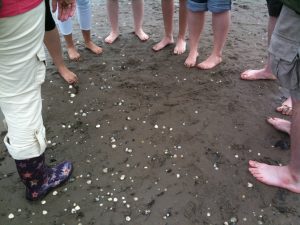
Maybe you are just starting your spiritual journey
Maybe you aren’t even sure where to begin or if you even want to begin a journey with God.
That’s totally OK, God knows you and loves you where you are.
Just be willing to be willing to begin!
IDEAS FOR THE JOURNEY:
Find a suitcase, or backpack, or use an old paper map to use as a visual symbol of your pilgrimage journey with Jesus. Put this in a place that you will see it each day.
You can print out a photo of a suitcase, or a backpack and put that in your journal, your bible, or hang it on your mirror, or pin it to a bulletin board near your desk so you can see it and allow it to remind you to journey with Jesus each day during Lent.
Place a pair of hiking boots and or a walking stick near your front door to remind you that you are on a pilgrimage journey with Jesus each day during Lent.
Pray a Labyrinth as a part of your Lenten Pilgrimage. Prayer walking a labyrinth was a lenten practice in the middle ages when going to the Holy Land became too dangerous for an actual pilgrimage.
Create a travel journal of your pilgrim journey during Lent. Write down the people you meet, the places you go, the things you notice along the way, just as you might do on an actual trip. On pilgrimage, everything is a gift from God, from the crying baby on the plane to the missed flight, so allow Jesus to teach you in the interruptions. Write down those too. You could also put in photos, sketches and/or souvenirs of your Lenten journey. This would be a great thing to do as a family.
Help your kids see the time between now and Easter as a pilgrimage journey with Jesus. Get them to tell you each day what they noticed and what God shows them. Have them draw pictures, or write stories of their daily travels with Jesus!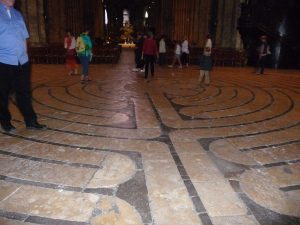
March 18th is St Patrick’s Day when we celebrate all things Celtic. In honor of Women’s History Month, I am reposting my favorite Celtic prayer – Brigid’s Feast as a preparation. It’s a great one to reflect on during Lent and especially with our current theme Breaking Down Walls. Brigit was a wall breaker if ever I knew one.
Brigid, (451-525 AD) is one of my favourite Celtic saints, She exemplified the wonderful gift of hospitality that Celtic Christians believed was not only meant to be a custom in their homes, it was a key into the Kingdom of God. To offer hospitality was seen as receiving Christ into their midst and fulfilling the law of love.
Brigid, who presided over the monastery at Kildare, was particularly known for her generous hospitality. As a child she often gave away her parents possessions. At Kildare, Brigid often made butter for visitors. Tradition has it that when churning the butter she would make thirteen portions – twelve in honour of the apostles and an extra one in honour of Christ which was reserved for guests and the poor.
The hospitality of Saint Brigit is reflected in the beautiful prayer above, which I often use as a grace before lunch at retreats that I conduct.
What is Your Response?
Brigid reminds us that the hospitality of God is a welcoming of Christ into our midst. Reflect on the times that you have offered hospitality to friends and strangers. Where have you been aware of Christ in your midst at those times?
Celtic Christians, like Brigid, often saw themselves as guests of the world, living lightly on this earth and not becoming attached to possessions or place. Every encounter of life revealed to them the God who they believed was both host and guest. Life was seen as a pilgrimage of revelation, each step drawing us closer to God.
What is your response?
Take a moment to pause and look around you. What do you notice that speaks of the generosity and hospitality of God? At home your attention may be caught by the dining room table, around which family and guests gather to eat and celebrate. Or photos and the gifts of friends and strangers to whom you have offered hospitality. Of maybe you are in the garden where even the wild brambles, and thistles – all the weeds you so diligently work to get rid of – are gifts from God and can produce the most delicious and nutritious food we can eat.
Sit in silent prayer to remind ourselves of the incredible hospitality of God who invites us, together with all creation, into the divine presence and into the eternal family.
Now watch the video below. What else is God saying to you about your need to be hospitable to those around you?
The music in this video is a part of our MP3 Brigit and the Hospitality of God which you can download here.
We are offering free books of poems by one of our community writers, Ana Lisa de Jong. New Zealand poet Ana Lisa De Jong has made her beautiful poems available for download on Godspace. These books are inspiring, contemplative and beautiful. Ana Lisa is an incredibly gifted writer and we are thankful she is offering some of her work to you. You can access these books through our shop with a free download and the links are below.
The Gate to Heaven: Poems for Contemplation
Broken Into Wholeness: Poems for Recovery
Poems for Loss; This collection includes over 100 pages of poetry on the theme of grief and loss, healing and hope, and coping with our present pains in the light of eternity.
If you’re a fan of Ana Lisa’s incredible work, consider downloading these free books in conjunction with her latest published book of poems Heart Psalms: Songs of The Heart, in which Ana Lisa’s poetry is accompanied with stunning scenic photography of New Zealand scenery, which makes her new book both a treasure to read and to look at. A wonderful resource for daily reflections, along with a tool for retreats and quiet times! You can also find other poetry books here on her amazon page to order or her website, Living Tree Poetry.
As an Amazon Associate, I receive a small amount for purchases made through appropriate links.
Thank you for supporting Godspace in this way.
When referencing or quoting Godspace Light, please be sure to include the Author (Christine Sine unless otherwise noted), the Title of the article or resource, the Source link where appropriate, and ©Godspacelight.com. Thank you!



